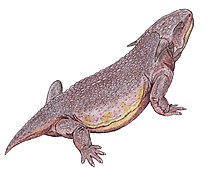|
Procolophonia
Procolophonia is an extinct suborder (clade) of herbivorous reptiles that lived from the Middle Permian till the end of the Triassic period. They were originally included as a suborder of the Cotylosauria (later renamed Captorhinida Carroll 1988) but are now considered a clade of Parareptilia. They are closely related to other generally lizard-like Permian reptiles such as the Millerettidae, Bolosauridae, Acleistorhinidae, and Lanthanosuchidae, all of which are included under the Anapsida or "Parareptiles" (as opposed to the Eureptilia). ClassificationThere are two main groups of Procolophonia, the small, lizard-like Procolophonoidea, and the Pareiasauroidea, which include the large, armoured Pareiasauridae. According to the traditional classification of Carroll 1988 as well as phylogenetic analyses of 2012, smaller groups like Rhipaeosauridae (now a synonym of Nycteroleteridae) and Sclerosauridae are classified with the pareiasaurs and with the procolophonids, respectively.[1] The Nyctiphruretidae was thought to represent the sister taxon of Procolophonia by many studies, however recently discovered material places it within the group, as the sister taxon of Procolophonoidea.[2] The following cladogram is simplified after the phylogenetic analysis of MacDougall and Reisz (2014) and shows the placement of Procolophonia within Parareptilia. Relationships within bolded terminal clades are not shown.[2]
Relationship to turtlesThe procolophonians were traditionally thought to be ancestral to the turtles, although experts disagreed over whether turtle ancestors would be found among the Procolophonidae, the Pareiasauridae (Lee 1995,1996, 1997), or simply a generic Procolophonian ancestor. Laurin & Reisz, 1995 and Laurin & Gauthier 1996 defined the Procolophonia cladistically as "The most recent common ancestor of pareiasaurs, procolophonids, and testudines (Chelonia), and all its descendants", and listed a number of autapomorphies. However, Rieppel and deBraga 1996 and deBraga & Rieppel, 1997 argued that turtles evolved from Sauropterygians, which would mean that the Parareptilia and Procolophonia constitute wholly extinct clades that are only distantly related to living reptiles. The first genome-wide phylogenetic analysis of turtle relationships was completed by Wang et al. (2013). Using the draft genomes of Chelonia mydas and Pelodiscus sinensis, the team used the largest turtle data set to date in their analysis and concluded that turtles are likely a sister group of crocodilians and birds (Archosauria).[3] This placement within the diapsids suggests that the turtle lineage lost diapsid skull characteristics as it now possesses an anapsid skull. References
External links
|
|||||||||||||||||||||||||||||||||||||||||||||||||||||



